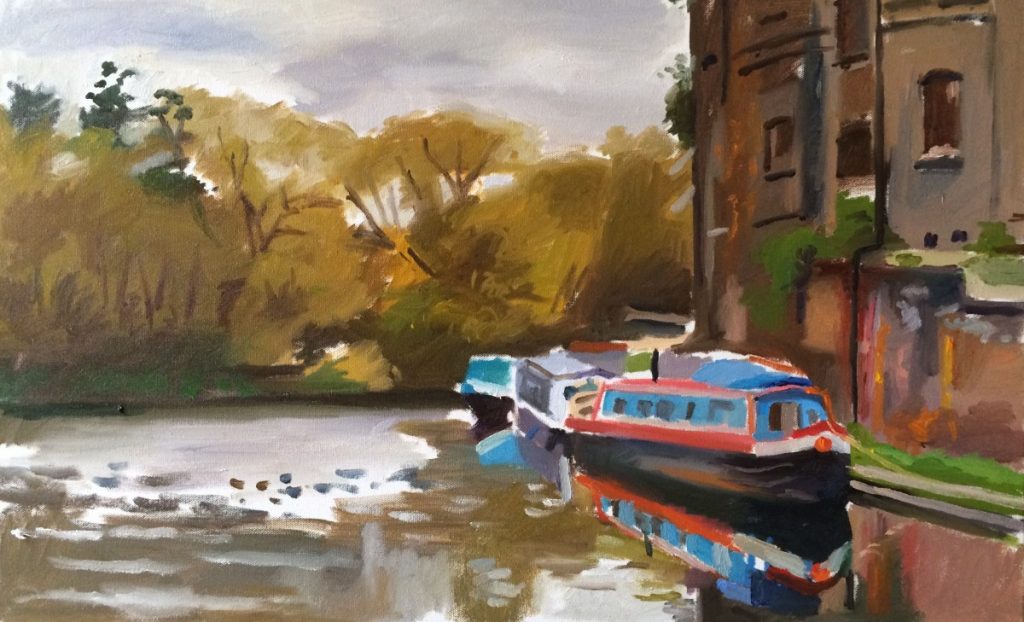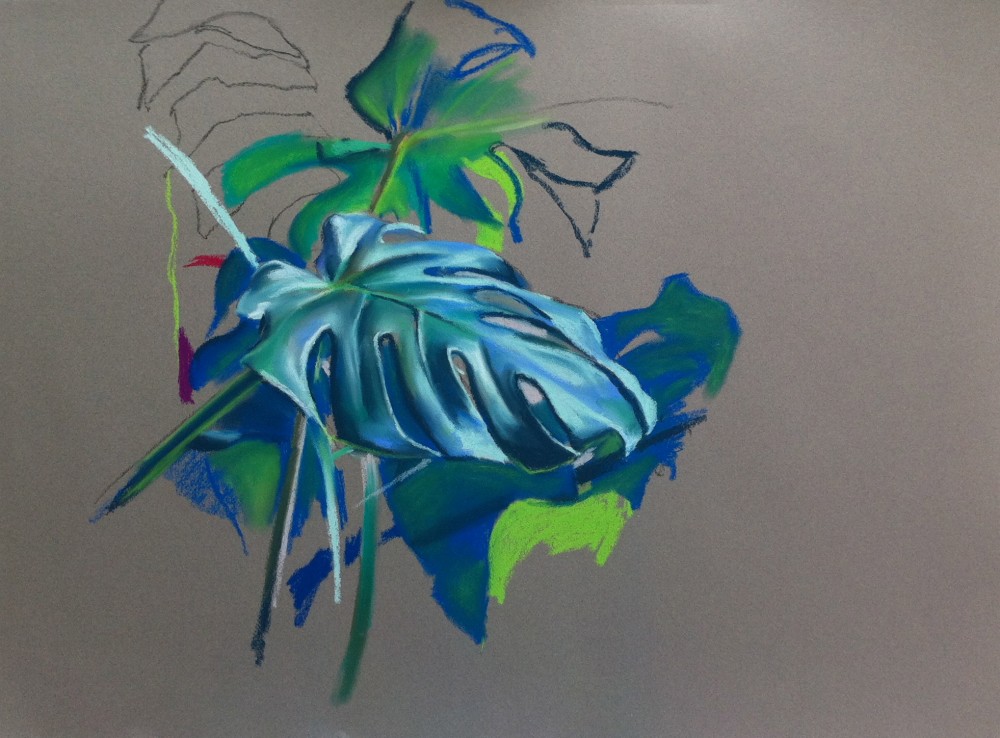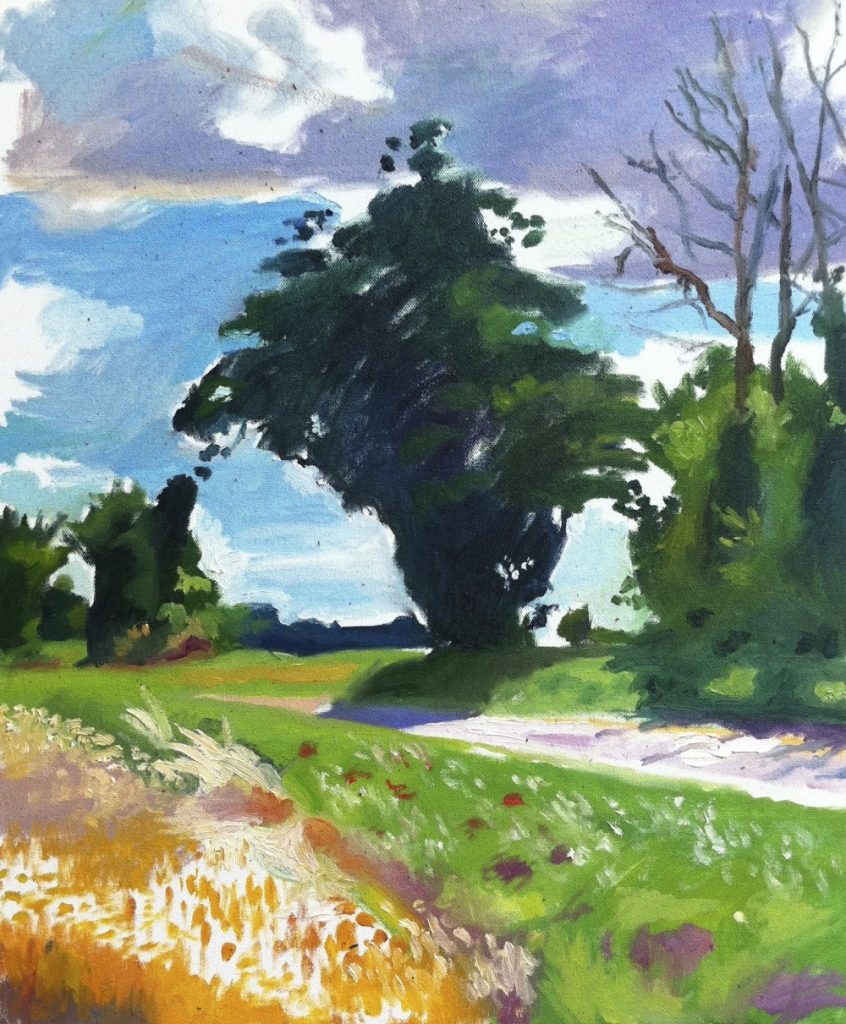Hero’s Mirror

Self-portrait in a convex mirror, Oil on Canvas,
Self-portrait in a Convex Mirror, Oil on Canvas, 28 x 26 inches
This very attractive convex mirror came from a barn in Cornwall and was lent to me by my friend Hero. The arrangement in the studio is mostly fortuitous. I liked the fact that it became not only a self-portrait, but a portrait of the long-suffering Dracaena in the centre, and also, in a way, a portrait of my studio.
Note: as ever, if you want to be notified each time I post, scroll down to the bottom of the blog and type your email in the box.
King’s Cross

Regent’s Canal (near Granary square), Oil on Canvas, 29 x 18 inches
The idea was to go to King’s Cross and paint cranes, JCBs, railways – all things industrial. But while I was looking for a spot, I bumped into Melissa who said: ‘Come along this way, there are some great things to paint along the canal’. So we went, but when we got to the place she had in mind, it was disappointing. ‘They’ve built this horrible new pontoon…That horrible modern building has covered up the view of St. Pancras…The boatyard is closed…They’ve got rid of all that nice graffiti…’
In other words, everything had been ruined in the name of progress.
In the end we retreated to this spot near Granary square. It’s carefully chosen. If you zoom away from it you will see hoardings done up in a horribly bland, fake-ivy design. Some people think painters are uncomfortable with the modern world – but what we really hate is not the modern, but the bland.
Feeling disgruntled, and slightly superior, as though we belonged to some secret anarchist sect, we started to paint. After a while the cold took its toll. Melissa said she was going to get coffee, and I suggested going to the nice-looking cafe that’s part of the new Central Saint Martin’s.
She came back about twenty minutes later with two coffees, a brownie and a banana cake.
Meanwhile, Alex, a young up and coming photographer and film-maker, had caught up with us, and was putting together his camera equipment.
‘They’re all yuppies in there,’ said Melissa.
‘Who?’ I said.
‘The people in that cafe.’
‘But I would have thought they would all be students…’
‘They’re all yuppies.’
There was an awkward silence. Then Alex cleared his throat and said in a voice that had become high-pitched with trepidation: ‘But Melissa, now I’m worried that I’m a yuppie.’
‘Into the canal with you, then,’ she said, and for the first time a smile crossed her lips.
The Secret Life of Plants

Monstera Deliciosa (Swiss cheese plant), Pastel on Paper, 21 x 30 inches
I have painted and drawn a lot of plants in my studio. I have not always been very good with them. Sometimes I don’t give them enough water, sometimes too much. Other times they have to suffer long periods of central heating. But they are good to have around because they are more like people than any other ‘thing’. I don’t mean that they feel emotions – I just mean that they are characterful, and become more so with time. I don’t particularly like cats, but I think they are beautiful to watch, and plants are similar in that they have an incredible range of movement, and when I draw them I can see them moving from one hour to the next. It might in some sense be ‘easier’, but it is a lot less fun to draw something that is not moving at all, which is why I prefer to always have something organic in a still life – even an apple is constantly changing. The thing that changes most obviously is a landscape, but often painting a portrait is a similar experience, which is why dividing things into genres – portrait, still life, nude, landscape – is so artificial: there is a landscape in every portrait and a portrait in every landscape.
While I was drawing my Monstera, someone suggested I read ‘The Secret Life of Plants’, a charming but nutty book, largely inspired by the work of Cleve Baxter, a polygraph instructor and one time interrogator for the CIA, who one day decided to do a polygraph test on the Dracaena Massangeana in his office (as one does). The original purpose was not to see whether the Dracaena was telling the truth or not (you only need to take one look at a Dracaena to see that they are perfectly honest) – but to test how quickly water travelled from the roots to the leaves. This simple aim soon yielded extraordinary and unexpected results: the Dracaena could read Baxter’s mind – whenever Baxter entertained nasty thoughts towards it, like wanting to burn one of its leaves, the polygraph went crazy. Further experiments on other plants revealed that they could tell what Baxter was thinking even when he was hundreds of miles away from them.
What must my Monstera have been thinking every time I forgot to water it? I suddenly felt very guilty, but at the same time it was comforting to think that the three potted plants in my studio always knew my state of mind. I started looking after them more, watering them regularly, lovingly wiping the dust from their leaves so that they could photosynthesize more freely.
Dogs are loyal, cats are graceful, but plants are discreet and never impose on you – so it’s worth looking after them.
Note: you can now follow this blog without signing up to WordPress, just scroll down to the bottom and click on ‘follow’. It will just ask for your email address, and you’ll get a notification each time I post.
The Meaning of Trees (and how to avoid military service)

Tree Near Ramsholt, Oil on Canvas, 32 x 22 inches
Another painting from Suffolk. It made me wonder why I zero in on particular trees. When I see a tree like this I find it almost irresistible. An uncle of mine, a psychologist, told me he was once approached by a young man who asked him how to get out of military service (this was in Poland back in the eighties). Simple, he said, when you come before the evaluation board, tell them that you got there on foot, that you had a very nice walk in the park, that there was a particular tree in the park that caught your attention, and that you couldn’t help feeling that it was trying to tell you something… The advice worked: he was turned down by the evaluation board.
This painting is a bit more colourful than some of my other landscapes. I think I was influenced at the time by David Hockney’s pictures of Yorkshire.

Recent Comments